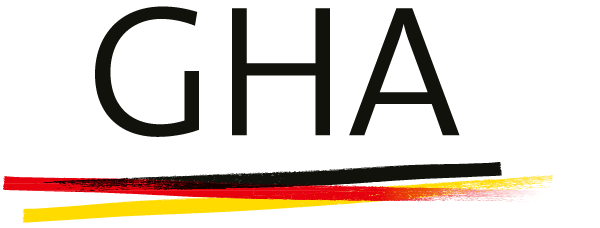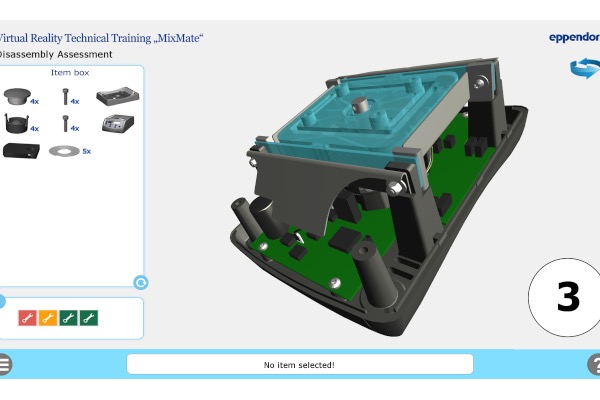Virtual Reality Simulation
SZENARIS creates virtual reality simulations for operators and maintenance personnel of complex devices. An example for a virtual reality simulation module in the medical area is the MixMate mixer from the global operating company Eppendorf AG.
Service and maintenance work on the MixMate product must be carried out regularly. For this target group the virtual reality module is divided into four chapters:
- Exploration –Structure and components of the MixMate (fig. 1)
- Demonstration – Instructed disassembly and assembly procedures of the MixMate (fig. 2)
- Training – Self-paced training of disassembly and assembly of the MixMate
- Assessment – Scored competence test to pass the module (fig. 3)
The high interactive virtual reality application uses the WebGL format, and can be used with current browser versions without additional plug-ins. It can be used on the platforms Windows, Mac OS X, iOS and Android. Communication between LMS and the virtual reality application is guaranteed by means of the SCORM standard interface.
The learner can turn the MixMate into all directions and can zoom in and out. It is possible to disassemble the MixMate and to put the components into the item box. The program provides hints for the needed tools in each step. The high detailed virtual reality objects represent the real MixMate in an outstanding quality. Moreover, the virtual reality allows to visualize perspectives, which cannot be envisioned in real life, e. g. showing the locations of the various components in the so-called X-Ray view.
This virtual reality simulation is based on a holistic training approach, which is explained in the following text:
Holistic Training Approach
The personnel operating and maintaining complex medical systems are expected to have the appropriate knowledge to safely operate the medical equipment after completing the training course. The challenge for the trainers is to pass on these skills as comprehensively and as fast as possible. In many cases, the actual medical equipment is not available for the training course, because it is very expensive or in use for real life surgeries.
Special educational methods are applied, in order to learn more efficiently and to gain qualified knowledge as well as the competency to perform the necessary tasks. In this context, the learned competencies encompass knowledge, skills as well as the determination and readiness to act. The successful learning process is indicated by the learner’s ability to perform the tasks independently.
The holistic training system is based on a so-called Learning Management System (LMS) that supports the trainers to organise, carry out and monitor the learning process. In order to prepare for everyday use as efficiently as possible, this system enables the trainee to learn independent of time and location.
The learning contents are a substantial part in the LMS. The smallest navigable unit in an LMS is a learning- or simulation module (fig. 4). Multiple modules are combined in courses custom-tailored for the target group. The trainer can configure courses differently, for example enabling random access to all modules in the course or prescribing a specified learning path. The learners participate in the courses that are provided for them.
Learning- and simulation modules are integrated via standard interfaces of the LMS such as SCORM or xAPI. The interface enables a communication between learning and simulation modules and the LMS, so that learning progress and success can be stored in the LMS for each trainee. Another advantage of using these standard interfaces is, that almost any LMS can be used. If the customers already have an established LMS, they can directly use it for the holistic training system. In Germany, schools and universities currently often use the LMS called ILIAS (www.ilias.de/en/), which has a high security standard.
In addition, media and information such as manuals, staff regulations, operation and technical documentations, dictionaries or Wikis can be integrated. Thereby, a direct access to these materials is enabled to acquire a more comprehensive knowledge while using the learning system.
Apart from that, educational materials for the trainer are stored in another area in the LMS.
Another important function is the communication between trainers and learners. The communication takes place via e-mail and chat. Thereby, learners are enabled to exchange information among each other and trainers can communicate with the group or with individual learners.
The trainers organise and monitor the training. They set up courses and provide them for the learners, considering their individual requirements. The trainers are the helmsmen of holistic training. They have an overview on the learning progress and success of the course participants at any time. The technical administration of the system is performed by the appropriate personnel.
The system is multilingual and can be accessed via intranet or internet.
The learning modules constitute the knowledge basis for the learners. Animations and narration are used to visualise and explain complex technical and functional issues. The scope and depth of the learning contents are targeted for the individual learning goals.
The virtual reality (VR) learning environment is setup with exercise parameters. Depending on the individual tasks, all required systems and devices are operable in the virtual reality.
The multi-user function supports the training of team-oriented tasks. In this function, several participants have to carry out specific tasks together, so that a higher level of competency can be reached.
In a holistic training system, learners acquire their basic knowledge by means of learning modules and additional information. They reach higher levels of competency by practicing real life situations in virtual reality and simulators.
Holistic training also comprises classroom or virtual classroom training. The individual training units or courses are concluded by practical training with actual equipment. The learners are guided by their trainers, who are responsible for their training success. The Learning Management System provides a powerful support for the trainers in this process.
The holistic training system is excellently suited to be used for initial training steps. The system enables independent, fast and high-quality staff training.
It is available throughout the entire lifecycle of the devices, so that new and existing staff can be continually trained on a regular basis.





